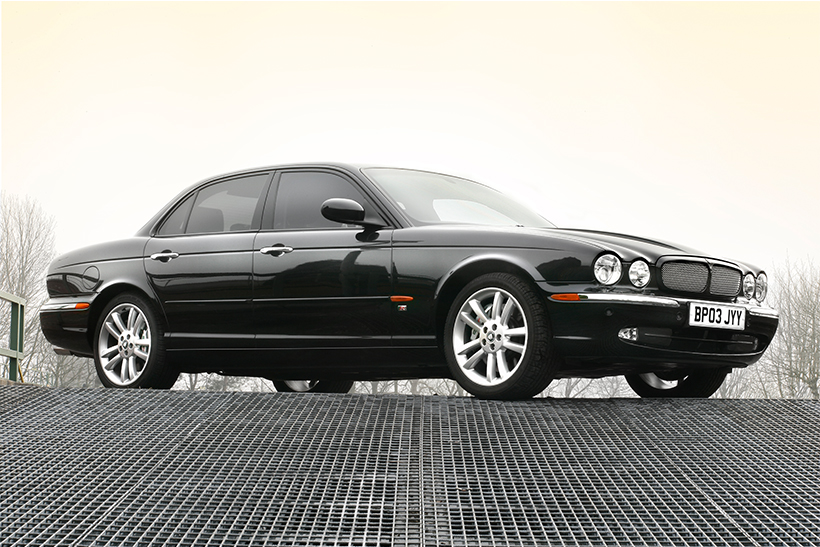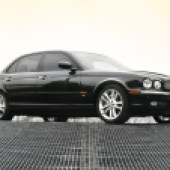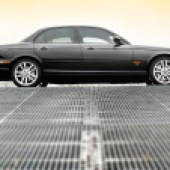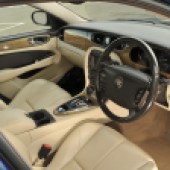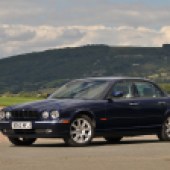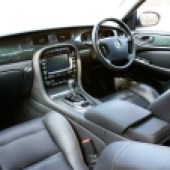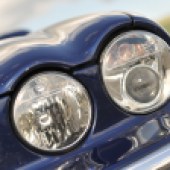The sixth generation of Jaguar’s XJ saloon hid radical lightweight technology under its retro looks. We take a closer look….
The chaps responsible for looking after the impressive Jaguar Heritage car collection told me a superb anecdote a while back: some years ago they needed to move the collection’s XJ8 and the easiest way to do it was simply to drive it. Simple enough, you might think but there followed an impromptu chat with the local constabulary who pointed out that driving what amounted to a giant mirror around the country’s motorway network would be somewhat frowned upon.
The car in question was the former Paris show car exhibit from 2002 and its appearance is explained by the fact that instead of being painted, its bare bodyshell was polished to a mirror finish – the better to point out to the public the car’s radical lightweight structure.
Development had in fact begun quite some time earlier, running alongside the ‘X400’ X-Type from 1997. The new XJ was required to be larger than the existing X300/X308 generation, especially in terms of cabin room and luggage space. This meant increasing the wheelbase to 3034mm, which ironically was almost identical to the Series 1 XJ, but in order to prevent the weight of the new car mushrooming, the decision was taken to create the body in aluminium.
Back in the early 21st century this was a radical step, with only Audi having successfully produced a large monocoque saloon car in aluminium but Ford provided the required resources and a construction method was developed which is still used by Jaguar today.
Unlike the extruded aluminium spaceframes used by Audi and Honda, Jaguar’s aluminium bodies employ bonded and riveted construction, with the high-tech glue being fully cured by the heat of the paint oven. It’s clever stuff and strong, too: in a recent tour of Jaguar’s F-Type assembly line, we were shown how the aluminium itself will fail before the adhesive lets go.

Despite this, there are still constraints imposed by aluminium’s relative lack of strength compared to a conventional steel body and this heavily influenced the style of the new car. As lead designer of the X350, Fergus Pollock (interviewed in CCM last month) points out that the need to retain torsional stiffness saw the pillars become wider and the waist line raised. The original ‘six-light’ styling concept (ie three side windows) proved impossible to manufacture as an aluminium panel which explains why the production car featured a more upright C-pillar and a simpler four-window treatment.
In his fascinating book Jaguar Design, former Jaguar designer Nick Hull also points out the rising feature line in the lower half of the rear doors which apparently helps to visually slim the sides of the car.
Aside from the technical requirements, the X350’s style was also influenced by internal politics, with opposed factions within Ford and Jaguar wanting either a traditional Jaguar face or a modern clean-sheet approach. In the end, extensive customer research saw the X350 employ a familiar Jaguar face, with the sculpted four-lamp front end familiar from the earliest XJ.
Although well received by the firm’s more conservative customers, this apparently wasn’t welcomed by incoming design chief Ian Callum, who reckoned that in becoming hooked up on recreating the look of the Series 1 XJ, the firm had missed an opportunity to break with tradition and create something more contemporary.
Shortly after the launch of the X350 he would indeed be proved at least partly right when the first of the Bangle-era BMWs was unveiled in the shape of the radical E65 7-Series – although in defence of the Jaguar, that car did face initial resistance from customers.
In the end the appearance of the car really didn’t matter a great deal, since road testers and customers alike were impressed by Jaguar’s newfound standards of quality and refinement – and, it must be said, pace. The regular XJ8 model now ran the 4.2-litre evolution of the AJ-V8 engine, rated at 298 bhp, with the supercharged version in the XJR knocking out a handy 400 bhp – identical to BMW’s M5. With the XJ weighing just 1600kg, the result was a rapid machine, with the XJ8 sprinting to 60 mph in just 6.3 seconds and the XJR in 5.9 seconds, both topping out at a limited 155 mph. For those not needing such fearsome pace, an entry-level XJ6 was offered with a 3-litre V6 good for 240 bhp, but for many the big news was the availability of a diesel engine for the first time in the XJ. Badged as TDVi, this was a 2.7-litre twin-turbo V6 unit co-developed by Jaguar parent Ford with Peugeot and good for 204 bhp backed up with a crushing 321lbf.ft torque – more than the naturally-aspirated V8 in fact.
Underneath, the X350 sat on adaptive air suspension at all four corners which combined with the car’s light weight to make it a nimble handler for its size and the XJ8 is something of a Q-car.

Facelifted in 2007 for the 2008 model year, the X350 gained revised grille, mirrors and front bumpers plus the side vents in the wings but would be replaced by the radically different-looking X351 in 2009. This may have boasted a cutting-edge style similar to the XF but underneath it was the same platform as the X350, showing just how modern the car was despite its retro styling.
Right now, the X350 generation is something of a bargain as a modern classic and despite its aluminium construction and air suspension really isn’t that demanding to live with for the keen DIY owner. How do we know? Because our own Kelsey Media fleet includes a 2002 XJ8 which has proved to be a favourite among the CW team and remains a superb way to rack up the miles on a long trip. With early cars starting at under £4000 there’s never been a better time to buy.
TECH SPEC 2002 Jaguar XJ X350
ENGINE: 4196cc V8
POWER: 300 bhp at 6000rpm
TORQUE: 310 lbf.ft at 4100 rpm
MAX SPEED: 155 mph
0-60 mph: 6.3 secs
GEARBOX: six-speed automatic
WEIGHT: 1615 kg

